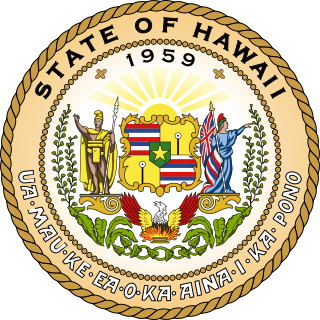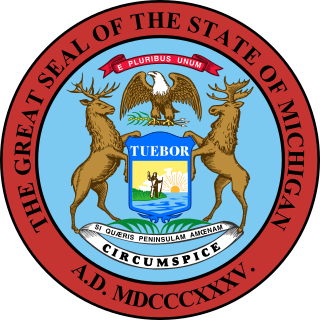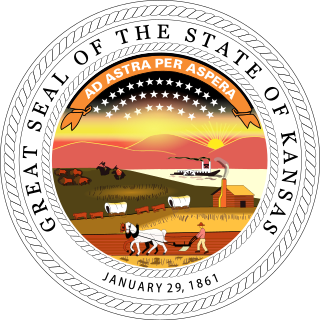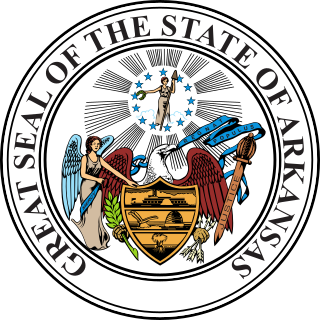Related Research Articles
A state legislature in the United States is the legislative body of any of the 50 U.S. states. The formal name varies from state to state. In 27 states the legislature is simply called the Legislature or the State Legislature, while in 19 states the legislature is called the General Assembly. In Massachusetts and New Hampshire, the legislature is called the General Court, while North Dakota and Oregon designate the legislature the Legislative Assembly.

A veto is the power to unilaterally stop an official action, especially the enactment of legislation. A veto can be absolute, as for instance in the United Nations Security Council, whose permanent members can block any resolution, or it can be limited, as in the legislative process of the United States, where a two-thirds vote in both the House and Senate will override a presidential veto of legislation. A veto may give power only to stop changes, like the US legislative veto, or to also adopt them, like the legislative veto of the Indian president, which allows him to propose amendments to bills returned to Parliament for reconsideration.

The California State Legislature is a bicameral state legislature consisting of a lower house, the California State Assembly, with 80 members; and an upper house, the California State Senate, with 40 members. Both houses of the Legislature convene at the California State Capitol in Sacramento. The California state legislature is one of just ten full-time state legislatures in the United States.

The Alaska Legislature is the state legislature of the U.S. state of Alaska. It is a bicameral institution consisting of the 40-member Alaska House of Representatives and the 20-member Alaska Senate. There are 40 House Districts (1–40) and 20 Senate Districts (A–T). With a total of 60 lawmakers, the Alaska Legislature is the smallest bicameral state legislature in the United States and the second-smallest of all state legislatures. There are no term limits for either chamber.

The Massachusetts General Court is the state legislature of the Commonwealth of Massachusetts. The name "General Court" is a hold-over from the earliest days of the Massachusetts Bay Colony, when the colonial assembly, in addition to making laws, sat as a judicial court of appeals. Before the adoption of the state constitution in 1780, it was called the Great and General Court, but the official title was shortened by John Adams, author of the state constitution. It is a bicameral body. The upper house is the Massachusetts Senate which is composed of 40 members. The lower body, the Massachusetts House of Representatives, has 160 members. It meets in the Massachusetts State House on Beacon Hill in Boston.

The Maryland General Assembly is the state legislature of the U.S. state of Maryland that convenes within the State House in Annapolis. It is a bicameral body: the upper chamber, the Maryland Senate, has 47 representatives and the lower chamber, the Maryland House of Delegates, has 141 representatives. Members of both houses serve four-year terms. Each house elects its own officers, judges the qualifications and election of its own members, establishes rules for the conduct of its business, and may punish or expel its own members.

The Colorado General Assembly is the state legislature of the State of Colorado. It is a bicameral legislature that was created by the 1876 state constitution. Its statutes are codified in the Colorado Revised Statutes (C.R.S.). The session laws are published in the Session Laws of Colorado.

The Hawaii State Legislature is the state legislature of the U.S. state of Hawaii. The state legislature is a bicameral body consisting of a lower house, the Hawaii State House of Representatives, with 51 representatives, and an upper house, the 25-member Hawaii State Senate. There are a total of 76 lawmakers in the legislature, each representing single member districts across the islands. The powers of the legislature are granted under Article III of the Constitution of Hawaii. The legislature convenes at the Hawaii State Capitol building in the state capital of Honolulu, on the island of Oahu.

The Michigan Senate is the upper house of the Michigan Legislature. Along with the Michigan House of Representatives, it composes the state legislature, which has powers, roles and duties defined by Article IV of the Michigan Constitution, adopted in 1963. The primary purpose of the Legislature is to enact new laws and amend or repeal existing laws.

The Alaska State House of Representatives is the lower house in the Alaska Legislature, the state legislature of the U.S. state of Alaska. The House is composed of 40 members, each of whom represents a district of approximately 17,756 people per 2010 Census figures. Members serve two-year terms without term limits. With 40 representatives, the Alaska House is the smallest state legislative lower chamber in the United States.

The Florida Senate is the upper house of the Florida Legislature, the state legislature of the U.S. state of Florida, the Florida House of Representatives being the lower house. Article III, Section 1 of the Constitution of Florida, adopted in 1968, defines the role of the Legislature and how it is to be constituted. The Senate is composed of 40 members, each elected from a single-member district with a population of approximately 470,000 residents. Legislative districts are drawn on the basis of population figures, provided by the federal decennial census. Senators' terms begin immediately, upon their election. The Senate Chamber is located in the State Capitol building.

The West Virginia House of Delegates is the lower house of the West Virginia Legislature. Only three states—Maryland, Virginia and West Virginia—refer to their lower house as the House of Delegates.

The West Virginia Legislature is the state legislature of the U.S. state of West Virginia. A bicameral legislative body, the legislature is split between the upper Senate and the lower House of Delegates. It was established under Article VI of the West Virginia Constitution following the state's split from Virginia during the American Civil War in 1863. As with its neighbor and former constituent Virginia General Assembly, the legislature's lower house is also referred to as a "House of Delegates."

The government of Alabama is organized under the provisions of the 1901 Constitution of Alabama, the lengthiest constitution of any political entity in the world. Like other states within the United States, Alabama's government is divided into executive, judicial, and legislative branches. Also like any other state, these three branches serve a specific purpose in terms of power.

The Alabama Legislature is the legislative branch of the state government of Alabama. It is a bicameral body composed of the House of Representatives and Senate. It is one of the few state legislatures in which members of both chambers serve four-year terms and in which all are elected in the same cycle. The most recent election was on November 6, 2018. The new legislature assumes office immediately following the certification of the election results by the Alabama Secretary of State which occurs within a few days following the election.

The Kansas Legislature is the state legislature of the U.S. state of Kansas. It is a bicameral assembly, composed of the lower Kansas House of Representatives, with 125 state representatives, and the upper Kansas Senate, with 40 state senators. Representatives are elected for two-year terms, senators for four-year terms.

The Nevada Legislature is a bicameral body, consisting of the lower house, the Assembly, with 42 members, and the upper house, the Senate, with 21. With a total of 63 seats, the Legislature is the third-smallest bicameral state legislature in the United States, after Alaska's and Delaware's (62). The Nevada State Legislature as of 2019 is the first majority female State Legislature in the history of the United States. As of 2021, the Democratic Party controls both houses of the Nevada State Legislature.

The General Assembly of Arkansas is the state legislature of the U.S. state of Arkansas. The legislature is a bicameral body composed of the upper house Arkansas Senate with 35 members, and the lower Arkansas House of Representatives with 100 members. All 135 representatives and state senators represent an equal number of constituent districts. The General Assembly convenes on the second Monday of every other year. A session lasts for 60 days unless the legislature votes to extend it. The Governor of Arkansas can issue a "call" for a special session during the interims between regular sessions. The General Assembly meets at the Arkansas State Capitol in Little Rock.
John Kuehn is a politician from the state of Nebraska in the Midwestern United States. In 2014, he was elected to the Nebraska Legislature, representing a district in the south central part of the state. Kuehn is a member of the Republican Party.

The 2020 United States redistricting cycle is in progress following the completion of the 2020 United States census. In all fifty states, various bodies will re-draw state legislative districts. States that are apportioned more than one seat in the United States House of Representatives will also draw new districts for that legislative body.
References
- ↑ is a General Legislative Procedure. National Conference of State Legislatures, 2014. http://www.ncsl.org/documents/legismgt/ilp/.%5B%5D
- ↑ Buhrman, Matt. Missouri Veto Session 2014. KSPR News, 2014. www.kspr.com/news/local/missouri-veto-session-2014/.
- ↑ "Veto Sessions".
- ↑ Fairlie, John. The Veto Power of the State Governor. American Political Science Review, 1917, p. 474. https://www.jstor.org/stable/1944249.
- ↑ Buhrman, Matt. Missouri Veto Session 2014. KSPR News, 2014. ww.kspr.com/news/local/missouri-veto-session-2014/.
- ↑ Kagel, John Hankyoung Sung and Eyal Winter. Veto Power in Committees: An Experimental Study. Experimental Economics, 2010.
- ↑ General Legislative Procedures. National Conference of State Legislatures, 2014. http://www.ncsl.org/documents/legismgt/ilp/.%5B%5D
- ↑ "Veto Sessions".
- ↑ "Veto Sessions".
- ↑ General Legislative Procedures. National Conference of State Legislatures, 2014. http://www.ncsl.org/documents/legismgt/ilp/.%5B%5D
- ↑ Klemens, Michael D. Veto Session. Illinois Issues, 1991. www.lib.niu.edu/1991/ii910126.html.
- ↑ Buhrman, Matt. Missouri Veto Session 2014. KSPR News, 2014. ww.kspr.com/news/local/missouri-veto-session-2014/.
- ↑ Shanton, Karen. Wrap up of Veto Overrides in States with Veto Proof Legislatures and Divided Government. National Conference of State Legislatures, 2014. http://www.ncsl.org/blog/2013/10/28/